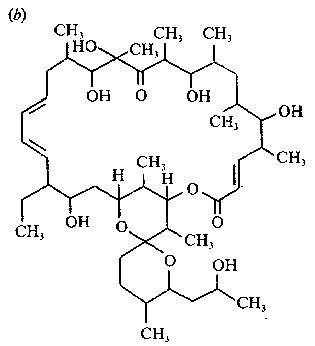Date: Wed Feb 2 02:02:25 2000
Posted By: Neil Saunders, Post-doc/Fellow, Molecular Cell Physiology, Vrije Universiteit
Area of science: Biochemistry
ID: 946328306.Bc
Message:
Dear Neha,
Thanks for the question. I'm not surprised that you had trouble locating
information about oligomycin, because the data that you were looking for
are very specialist and technical. I searched the web with every search
engine that I know of and I couldn't find very much either. In the end I
had to look in some very specialist journals with names like "Journal of
Antibiotics" and "Tetrahedron Letters" to find the information.
OK. First you ask, how does oligomycin affect cells? I wonder if I
should be telling you this-is part of the project not to find out how
oligomycin works? :-) The simple answer is that oligomycin inhibits an
enzyme called ATP synthase. This is the enzyme that makes ATP, the
chemical that all cells use for energy. The enzyme is made up of 2 major
parts, and if I tell you that one of them is called Fo, perhaps
you can guess that this part binds oligomycin. When oligomycin binds to
the enzyme, it can no longer make ATP from ADP plus phosphate. There are
2 very good pages on the web that explain how cells make ATP and where
oligomycin comes in:
http://arc-gen1.life.uiuc.edu/Bioph354/lect10.html
http://www-
isu.indstate.edu/thcme/mwking/oxphos.html
Next you ask for the structure of oligomycin. In fact there are several
types of oligomycin called A, B and C. Oligomycin A is the one that we
normally use. I scanned a picture of its structure for you from a paper,
here it is:
 In fact this is called 21-hydroxyl oligomycin A, you can probably work out
why. It looks complex but is actually quite a simple structure-this type
of compound is called a macrolide. It belongs to a large chemical family
called polyketides. One final chemical word that we use to describe this
structure is "spiroketal". These might all be useful words for you in a
web search.
In fact this is called 21-hydroxyl oligomycin A, you can probably work out
why. It looks complex but is actually quite a simple structure-this type
of compound is called a macrolide. It belongs to a large chemical family
called polyketides. One final chemical word that we use to describe this
structure is "spiroketal". These might all be useful words for you in a
web search.
You ask for its biochemical pathway. I'm not sure what you meant by this-
if you mean how does it work, the answer is above. If you mean how is it
synthesised, this work was done in 1986 in Manchester, England. The
researchers used simple carbon compounds (acetate, butyrate and
propionate) labelled with carbon-13, fed these to the cells then extracted
the oligomycin and looked at where the carbon-13 atoms were. In this way
they could see that oligomycin is assembled piece by piece from smaller
simple molecules containing carbon.
Finally, some "general" information. The "-mycin" part of oligomycin
tells you that it is isolated from the bacterium Streptomyces, an
organism that makes a lot of antibiotics. In fact oligomycin was first
identified in 1953 from a species called Streptomyces
diastatochromogenes, but it has since been found in lots of other
streptomycetes.
I hope this has answered some of your queries. This story illustrates a
common theme in science-often we use something a lot because it is useful
in an experiment, even though we don't know very much about it! If you
would like even more technical information (such as journal references),
please let me know.
Neil Saunders
Current Queue |
Current Queue for Biochemistry |
Biochemistry archives
Try the links in the MadSci Library for more information on Biochemistry.
MadSci Home | Information |
Search |
Random Knowledge Generator |
MadSci Archives |
Mad Library | MAD Labs |
MAD FAQs |
Ask a ? |
Join Us! |
Help Support MadSci
MadSci Network,
webadmin@www.madsci.org
© 1995-2000. All rights reserved.
 In fact this is called 21-hydroxyl oligomycin A, you can probably work out
why. It looks complex but is actually quite a simple structure-this type
of compound is called a macrolide. It belongs to a large chemical family
called polyketides. One final chemical word that we use to describe this
structure is "spiroketal". These might all be useful words for you in a
web search.
In fact this is called 21-hydroxyl oligomycin A, you can probably work out
why. It looks complex but is actually quite a simple structure-this type
of compound is called a macrolide. It belongs to a large chemical family
called polyketides. One final chemical word that we use to describe this
structure is "spiroketal". These might all be useful words for you in a
web search.